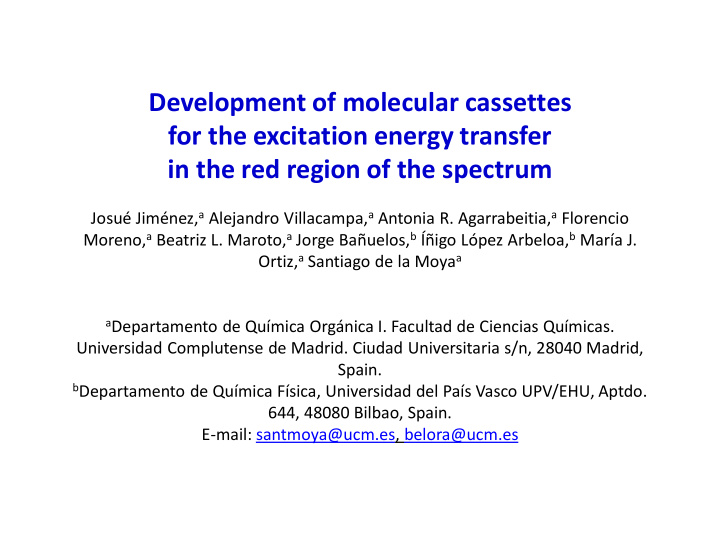



Development of molecular cassettes for the excitation energy transfer in the red region of the spectrum Josué Jiménez, a Alejandro Villacampa, a Antonia R. Agarrabeitia, a Florencio Moreno, a Beatriz L. Maroto, a Jorge Bañuelos, b Íñigo López Arbeloa, b María J. Ortiz, a Santiago de la Moya a a Departamento de Química Orgánica I. Facultad de Ciencias Químicas. Universidad Complutense de Madrid. Ciudad Universitaria s/n, 28040 Madrid, Spain. b Departamento de Química Física, Universidad del País Vasco UPV/EHU, Aptdo. 644, 48080 Bilbao, Spain. E-mail: santmoya@ucm.es, belora@ucm.es
Development of molecular cassettes for the excitation energy transfer in the red region of the spectrum Introduction and background EET Donor Acceptor Chromophore Chromophore Excitation Energy Transfer (EET) Cassettes Advanced materials for photonic technologies: - Solar harvesting - Fluorescence microscopy - Biomolecular probing
Development of molecular cassettes for the excitation energy transfer in the red region of the spectrum Introduction and background Easily derivatizable Modulable organic fluorophores - High molar absorption coefficients ( ε ) - High fluorescence quantum yields ( ) - Sharp fluorescence peaks BODIPYs Development of photonic tools: APPLICATIONS - bioimaging - chemosensing - lasing
Development of molecular cassettes for the excitation energy transfer in the red region of the spectrum Introduction and background - Reabsorption of emitted light Small Stokes shifts - Effects from excitation light scattering BODIPYs Development of Energy Transfer Cassettes with large pseudo-Stokes shifts
Development of molecular cassettes for the excitation energy transfer in the red region of the spectrum Introduction and background exc λ flu (%) Δν St (cm – 1 ) BODIPY (nm) (nm) 470 546 89 800 1 250 546 89 26130 470 552 94 750 2 552 94 9970 250 404 0,6 16600 n -hexane Sánchez-Carnerero, E. M.; Gartzia Rivero, L.; Moreno, F.; Maroto, B. L.; Agarrabeitia, A. R.; Ortiz, M. J.; Bañuelos, J.; López- Arbeloa, I.; de la Moya, S. Chem. Commun . 2014 , 50 , 12765.
Development of molecular cassettes for the excitation energy transfer in the red region of the spectrum Objectives Fluorophores with medical applications red/NIR region biological window (650 -1000 nm): - Minimize autofluorescence - Minimize absorption by water, tissues and cells - Less light scattering Deeper penetration by incident light ? Red emission
Development of molecular cassettes for the excitation energy transfer in the red region of the spectrum Objectives flu (hexane) = 599.5 flu (hexane) = 561.5 (hexane) = 0.36 (hexane) = 0.74 red emission red emission Cassette? Cassette?
Development of molecular cassettes for the excitation energy transfer in the red region of the spectrum Results Synthesis
Development of molecular cassettes for the excitation energy transfer in the red region of the spectrum Results ab max ·10 -4 solvent λ fl (nm) Δν St Ф BODIPY (M -1 cm -1 ) (cm -1 ) (nm) Photophysical PM650 c -hexane 589.5 5.3 599.5 285 0.36* properties acetone 588.0 3.5 606.0 505 0.11* 3 n -hexane 587.0 3.6 ** ** ** acetone 587.5 3.1 ** ** ** PM605 n -hexane 547.5 8.3 561.5 455 0.74 ICT acetone 542.0 7.1 559.0 560 0.70 4 n -hexane 549.5 5.6 579.5 940 0.13 acetone 545.5 5.3 563.5 585 0.011 *Fluorescence deactivation by ICT due to the strongly electron-withdrawing cyano group. **No signal was detected. High deactivation of the fluorescence!! ICT Problem Intramolecular Charge Transfer (ICT): From electron rich O -BINOL to electron poor BODIPY
Development of molecular cassettes for the excitation energy transfer in the red region of the spectrum Results ICT Solution Photophysical properties Less electron-donor O -BINOL ICT ICT? ICT? High deactivation of the fluorescence!! ICT Problem Intramolecular Charge Transfer (ICT): From electron rich O -BINOL to electron poor BODIPY
Development of molecular cassettes for the excitation energy transfer in the red region of the spectrum Results Synthesis
Development of molecular cassettes for the excitation energy transfer in the red region of the spectrum ab max ·10 -4 Results solvent λ fl (nm) Δν St Ф BODIPY (M -1 cm -1 ) (cm -1 ) (nm) Photophysical PM650 c -hexane 589.5 5.3 599.5 285 0.36 properties acetone 588.0 3.5 606.0 505 0.11 3 n -hexane 587.0 3.6 - - - acetone 587.5 3.1 - - - 5 n -hexane 589.5 4.9 603.5 395 0.25 acetone 591.0 4.4 619.0 765 0.02 PM605 n -hexane 547.5 8.3 561.5 455 0.74 acetone 542.0 7.1 559.0 560 0.70 4 n -hexane 549.5 5.6 579.5 940 0.13 acetone 545.5 5.3 563.5 585 0.011 6 n -hexane 552.5 6.1 575.0 710 0.60 acetone 549.0 6.0 572.0 730 0.45 High improvement of the fluorescence!! Less deactivation by ICT
Development of molecular cassettes for the excitation energy transfer in the red region of the spectrum Results EET behaviour exc λ flu (%) BODIPY Δν St (cm – 1 ) (nm) (nm) 570 604 0.25 395 5 250 604 0.25 27900 EET 100%, large pseudo-Stokes shift, red emission 510 575 0.60 710 6 250 575 0.60 27050 n -hexane
Development of molecular cassettes for the excitation energy transfer in the red region of the spectrum Conclusions Effcient EET cassette with red emission “red” BODIPY Electron-withdrawing groups EET 100% up to 60% diminish ICT Fluorescence
Recommend
More recommend